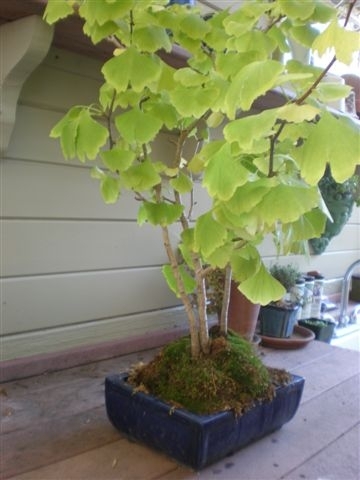By Barbara Ott, Butte County Master Gardener, April 19, 2016.

The word Bonsai is a translation from Japanese and literally means “planted in a tray,” a definition which indicates the relationship between these miniature trees and the low pottery containers which complement them. The pot ‘frames' the tree and creates a sense of harmony, without detracting attention from the tree. This horticultural art form was first developed by the Chinese (as penjing) and then refined under the influence of Japanese Zen Buddhism over a thousand years. A bonsai tree has been subjected to a number of horticultural practices with the aim of achieving visual harmony and creating a living object worthy of contemplation. The gardener tells a story through living illusion, a representation of a tree as it lives in the elements of nature (water, ice, wind, rocks) over time.
Bonsai are created from woody-stemmed evergreen or deciduous trees or shrubs that produce true branches and tolerate having their root/food storage capability restricted through crown and root pruning as well as confinement in a pot. Full-size trees can grow roots that are many yards long and root structures encompassing several thousand yards of soil. In contrast, a typical bonsai container is usually less than 15 inches wide, and filled with between two and ten quarts of soil. Bonsai tree roots live in this small space. While regular mature trees grow to 16 feet or more, bonsai rarely exceed 4 feet in height, and many are under 18 inches.
The confined root systems of bonsai trees affect the maturation, transpiration, nutrition, pest resistance, and many other aspects of tree biology. Skill is needed to control the degree of stress that a tree will tolerate while remaining healthy. Bonsai gardeners use cultivation techniques of pruning, root reduction, potting, defoliation, and grafting to produce small trees that mimic the shape and style of mature, full-size trees. To maintain healthy trees, they develop the knowledge to recognize the degree to which a particular technique is required, and how much is too little. Most bonsai are outdoor plants needing some protection from severe elements. Some tropical bonsai need to be brought indoors in winter.
Many plants commonly grown as yard trees, bushes, or hedges are suitable candidates for bonsai. Once selected, the chosen tree or plant is then trained and shaped over time to stay small and to meet the aesthetic standards of bonsai. Once the bonsai nears its planned final size it is planted in a small complementary display pot. From then on throughout the year the bonsai is shaped to limit growth, redistribute leaf vigor to areas requiring further development, and meet the gardener/artist's design.
The art of bonsai is a horticultural pastime requiring basic garden sense, some artistic ability and plenty of patience. Indeed, patience is an important attribute for bonsai gardeners, because the growth process takes time, and there are no shortcuts. In this way, practicing the art of bonsai requires one to slow down, observe carefully, and appreciate nature on a small scale – all of which are attributes we might all benefit from cultivating.
To get started with bonsai, the Sunset Bonsai book (2003) is a good beginning reference. Meetings of the Chico's own Bonsai Society are held at the Butte County Library (1108 Sherman Avenue, Chico) at 10:30 a.m. on the second Sunday of the month. For further information, see
http://chicobonsaisociety.com/
Photo credit: Ginkgo Bonsai by Sharon Rico, Solano County, Master Gardener